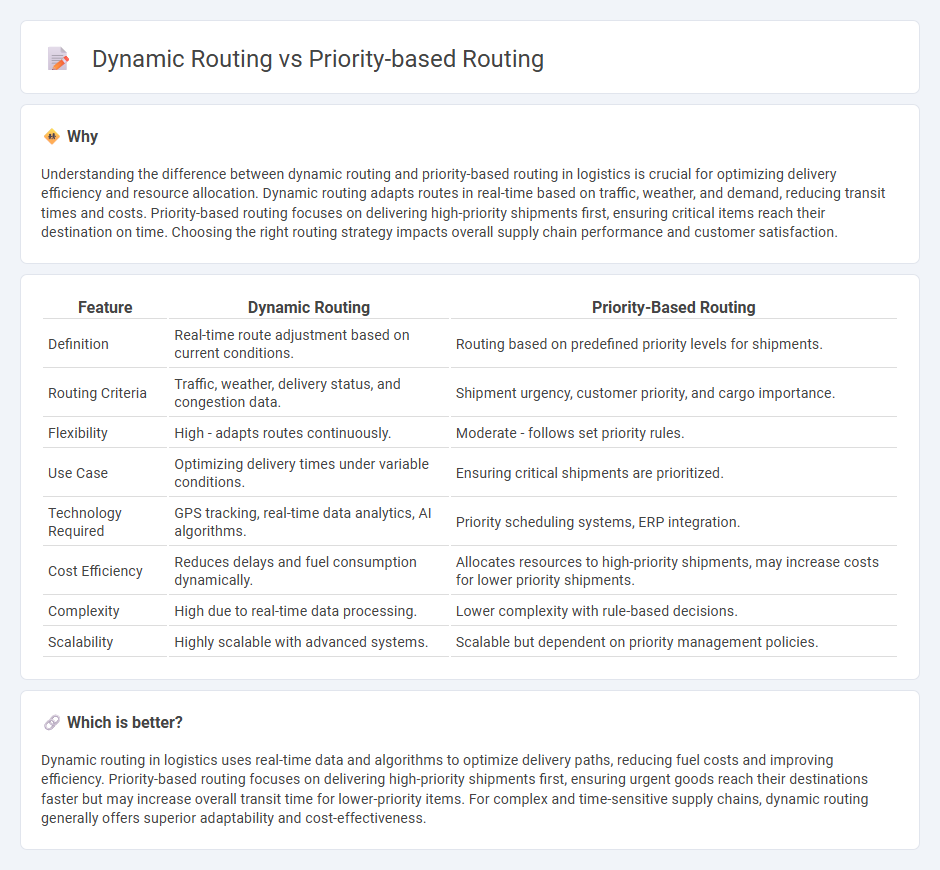
Dynamic routing in logistics uses real-time data and algorithms to optimize delivery paths, reducing transit times and fuel consumption. Priority-based routing focuses on predefined criteria such as shipment urgency or customer importance to allocate resources more effectively. Explore further to understand how these routing strategies enhance supply chain efficiency.
Why it is important
Understanding the difference between dynamic routing and priority-based routing in logistics is crucial for optimizing delivery efficiency and resource allocation. Dynamic routing adapts routes in real-time based on traffic, weather, and demand, reducing transit times and costs. Priority-based routing focuses on delivering high-priority shipments first, ensuring critical items reach their destination on time. Choosing the right routing strategy impacts overall supply chain performance and customer satisfaction.
Comparison Table
| Feature | Dynamic Routing | Priority-Based Routing |
|---|---|---|
| Definition | Real-time route adjustment based on current conditions. | Routing based on predefined priority levels for shipments. |
| Routing Criteria | Traffic, weather, delivery status, and congestion data. | Shipment urgency, customer priority, and cargo importance. |
| Flexibility | High - adapts routes continuously. | Moderate - follows set priority rules. |
| Use Case | Optimizing delivery times under variable conditions. | Ensuring critical shipments are prioritized. |
| Technology Required | GPS tracking, real-time data analytics, AI algorithms. | Priority scheduling systems, ERP integration. |
| Cost Efficiency | Reduces delays and fuel consumption dynamically. | Allocates resources to high-priority shipments, may increase costs for lower priority shipments. |
| Complexity | High due to real-time data processing. | Lower complexity with rule-based decisions. |
| Scalability | Highly scalable with advanced systems. | Scalable but dependent on priority management policies. |
Which is better?
Dynamic routing in logistics uses real-time data and algorithms to optimize delivery paths, reducing fuel costs and improving efficiency. Priority-based routing focuses on delivering high-priority shipments first, ensuring urgent goods reach their destinations faster but may increase overall transit time for lower-priority items. For complex and time-sensitive supply chains, dynamic routing generally offers superior adaptability and cost-effectiveness.
Connection
Dynamic routing optimizes delivery efficiency by continuously adjusting routes based on real-time data, while priority-based routing directs shipments according to their urgency and importance. Both methods enhance supply chain responsiveness by integrating factors like traffic conditions, delivery deadlines, and customer priorities. This connection ensures cost-effective logistics operations with improved on-time delivery rates and resource allocation.
Key Terms
Priority-based routing:
Priority-based routing directs network traffic by assigning different priority levels to data packets, ensuring that high-priority packets are transmitted ahead of lower-priority ones to optimize performance in congested networks. It is commonly used in real-time applications like VoIP and video conferencing where latency and packet loss must be minimized. Explore how priority-based routing can enhance your network efficiency and quality of service.
Service Level Agreement (SLA)
Priority-based routing ensures traffic is routed according to predefined service levels, guaranteeing that high-priority applications meet strict SLA requirements by reducing latency and packet loss. Dynamic routing adapts to network changes in real-time, optimizing paths to maintain SLA compliance through efficient bandwidth utilization and minimizing downtime. Explore more to understand which routing method best aligns with your SLA obligations and network performance goals.
Order Prioritization
Priority-based routing allocates network paths based on predefined priority levels, ensuring high-priority orders are transmitted with minimal delay to meet critical deadlines. Dynamic routing adjusts pathways in real-time, optimizing traffic flow but potentially causing latency for lower-priority orders due to changing network conditions. Explore the advantages and trade-offs of each method to enhance order prioritization strategies in your logistics system.
Source and External Links
Traffic routing methods to origin - Azure Front Door - Learn Microsoft - Priority-based routing in Azure Front Door routes traffic to the highest priority origin first and fails over to lower priority origins if the higher priority origin becomes unavailable, supporting Active/Standby deployment for high availability.
Azure Traffic Manager - traffic routing methods | Microsoft Learn - Azure Traffic Manager's Priority routing method directs traffic to a primary endpoint and automatically reroutes to backup endpoints based on their priority order if the primary endpoint becomes unavailable, ensuring reliable failover.
A Priority-Based Model of Routing - This paper introduces a priority-based selfish routing model where agents have different priority levels on links, affecting their delays and costs, and analyzes the efficiency and optimality of routing under this priority scheme.
 dowidth.com
dowidth.com